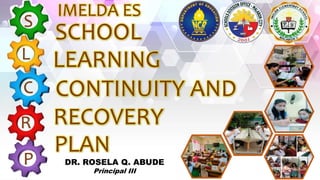The document provides details on Imelda ES's School Learning Recovery and Continuity Plan (SLRCP) for the 2022-2023 school year. It includes information on enrollment numbers which dropped during the pandemic but are gradually increasing. It also outlines the methodology used to organize classes, deploy teachers, and develop the daily class schedule/programming to ensure curriculum delivery across key stages in compliance with Department of Education guidelines. Physical facility preparations are also addressed to support health and safety. Curriculum delivery plans specify which subjects will be taught and not taught at each grade level.
































































